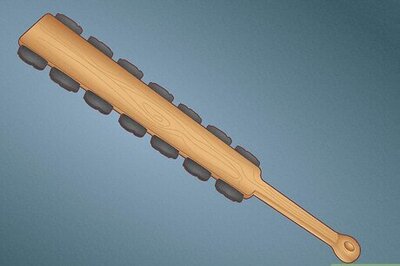
views
X
Expert Source
Kevin Stone, MDBoard Certified Orthopaedic Surgeon
Expert Interview
Depending on the severity of the strain, you might be able to get back to your regular levels of physical activities in as little as a month. Always consult your doctor for professional medical advice and follow all their recommendations.
Working with Your Doctor

Visit your doctor to get your injury examined. There are many different types of hamstring strains, so it’s important to get your injury looked at by a doctor to evaluate the seriousness and get treatment recommendations. If you have severe pain or if your pain hasn’t improved after 3–5 days of rest, schedule an appointment with your doctor. Have someone drive you to your appointment.Tip: Hamstring strains can be a pull, a partial tear, or a complete tear and are graded as a level 1, level 2, or level 3 strain, respectively. A grade 1 strain is not serious and can heal in just a few weeks, whereas a grade 3 strain may take months to heal or may require surgery to repair. Your doctor will do a preliminary physical examination that can include things like palpating and pressing your leg to determine where the injury is and how severe it is. If your doctor deems it necessary, they might also do some x-ray imaging to diagnose more serious strains. This is usually only done for very severe tears where the injured tendon may have torn away a small piece of bone since soft tissue injuries won’t show up on an x-ray. An MRI may be used to determine the pattern and degree of the tear.

Ask your doctor for a professional physical therapy referral. The therapists will help you recover faster with guided stretching, soft tissue massage, and specific exercises to rehabilitate your injury. Ask the physical therapist to recommend exercises you can do at home.

Follow all your doctor’s treatment recommendations. Wear a knee splint if your doctor recommends it and stay off your leg for the amount of time your doctor specifies. See a physical therapist if your doctor thinks it’s necessary, and don’t return to sports activities until your doctor says it’s OK. Always defer to your doctor’s professional medical advice to treat and rehabilitate your strained hamstring. There are general guidelines you can follow, but your doctor will always be able to provide you with the most specific medical recommendations for your unique injury. Alternate using heat packs and ice to help diminish the swelling.
Accelerate healing with an injection. In some cases, your doctor may recommend you get a PRP or other growth factor injection to help your hamstring heal. These injections contain growth factors with can stimulate your body to accelerate the healing process.

Get surgery performed for severe hamstring injuries. Surgery is sometimes required to reattach a completely torn tendon. Your doctor will discuss this with you if your injury is severe enough to warrant surgery. During such a surgery, the surgeon will reattach the torn hamstring muscle to the bone using stitches and suture anchors to stitch any tears within the muscle back together. If you have to get surgery, your surgeon will provide you with specific instructions for aftercare and rehabilitation.
Resting and Reducing Swelling

Modify physical activity as much as possible. You can still do some specific fitness training, as long as you protect the area that is injured. Avoid overloading your strained hamstring. You can use a cane or crutches to help you get around to protect the injured area. Pool exercises are often helpful—the water helps provide mild resistance and a cooling effect on the damaged area.

Ice your injured hamstring for 20 minutes at a time every 3-4 hours while awake. Apply cold packs or bags of ice to your hamstring over your clothes or wrapped in a towel to reduce swelling. Don’t apply ice to your bare skin. Icing can burn the skin, which is why it’s important to always have something like clothing or a towel between the ice and your injured hamstring. Start icing your hamstring as soon as possible after you strain it. Icing is most effective during the first 48 hours after an injury.

Wear a compression bandage or compression shorts. Wrap a compression bandage around your strained hamstring or put on a pair of compression shorts. This will help minimize and prevent further swelling. Either elastic compression bandages or sports wraps are the best way to compress your hamstring because you can adjust them as needed. Wear compression shorts if that’s all you have. Compression bandages are available at your local pharmacy.

Elevate your leg while you’re resting. Put your leg up on a chair when you’re sitting down or stick a pillow under it to elevate it when you’re lying down. This will help reduce swelling.Tip: To help you remember what to do to treat your strained hamstring, remember the acronym RICE. This stands for Rest Ice Compress Elevate. This is most effective if you can elevate your leg above your heart. For example, you could lie down on the floor and put your leg up on a chair or a stack of pillows.

Take an over-the-counter painkiller to reduce discomfort and inflammation. Take a mild pain medication like ibuprofen or acetaminophen in the dose recommended on the packaging. Only do this if your hamstring is hurting a lot after you initially strain it and stop taking the medication as soon as the pain is manageable. If you haven’t taken a certain painkiller before, make sure you read the warnings and suggestions on the packaging. Certain pain medications are not recommended for people with other conditions, for example. You can always consult a doctor if you aren’t sure.
Exercising and Stretching

Massage the back of your thigh to help loosen up the muscles. Start by applying a warm massage oil, such as coconut or almond oil, and rub it into your skin. Press down as hard as you can without causing pain and rub your hamstring in circles. Continue rubbing the sore area until you start feeling relief. You can follow up with an Epsom salt bath to keep your muscles loose.

Start doing gentle stretches daily after all the initial sharp pain is gone. Wait at least 2-3 days to start stretching your injured hamstring. Make sure you don’t feel any sharp pain in your hamstring anymore before you start doing daily stretches. It’s normal and OK if you still feel mild discomfort in the back of your leg and the stretching will help this go away. One example of a hamstring stretch you can do is a prone knee bend. Lie flat on your stomach with your legs out straight. Bend the knee on your injured leg up and back towards your buttocks and hold it for 5 seconds, then lower it back down. Do 2 sets of 15 repetitions. Another hamstring stretch you can do is to lie on your back on the floor with your buttocks almost in the middle of a doorway and your legs through the doorway. Lift your injured leg up and rest it against the wall next to the door frame for 15-30 seconds. Repeat this stretch 3 times. A yoga mat can make doing stretches and exercises on the floor more comfortable. You can order one online or have a friend or family member go pick one up for you from a sporting goods store.

Add daily strengthening exercises into your routine after all the pain is gone. The pain in your injured hamstring will usually subside after 1-2 weeks of stretching for a mild strain, 2-6 weeks for a moderate strain, and 6-10 weeks for a moderate strain. Begin light strength training like cycling, walking, and exercises that target your hamstrings specifically after you don’t feel any more pain and tightness in the back of your leg. For example, you can do chair lifts to target your hamstrings and strengthen your strained hamstring. Lie down on your back with your heels elevated on a chair and your legs straight. Raise both your hips slowly up off the floor, hold them in the air for 2 seconds, then lower them slowly back down. Do 3 sets of 15 repetitions. You can go for light walks or bike rides, but avoid strenuous routes with lots of hills.

Return to sports activity after several weeks when you regain your strength. Wait at least 3-4 weeks and up to 3 months before you do any of your regular athletic activities. Ask your doctor if you aren’t sure whether your hamstring is strong enough to do sports activities yet.Warning: If you return to athletics too soon, you can end up injuring your hamstring again very easily and even cause a chronic condition. It’s very important to be sure that your hamstring is rehabilitated before you start sports again. Don’t push yourself or feel pressured to return to sports or athletic activities too soon. Wait until you feel as strong and flexible as you did before your injury or until your doctor says it’s OK.


















Comments
0 comment